Master the Art of Steaming: A Beginner’s Guide

Learn how steaming, a very old and simple way to cook, makes your meal prep healthier. It keeps the taste and texture good too. Whether it’s making milk frothy for a creamy cappuccino or cooking salmon just right, steaming is important. It brings out the best in your food’s nutrients and tastes. This guide will show you the basics of steaming, from the tools you need to how to do it. This will help you make your food even better.
Key Takeaways
- Understand steaming as a method that uses hot steam instead of boiling in water.
- See steaming as a good and flexible way to cook many foods like fish and veggies.
- Know that the right tools, like a bamboo steamer or steam oven, are key for good steaming.
- Use steaming to make meal prep quick. Most foods cook in 5 to 15 minutes.
- Learn to not pack the food too tight to get the best results.
- Find out that steaming works for many types of food, from Asian to Mediterranean dishes.
- Appreciate steam ovens for being good with energy and having settings for precise cooking.
Understanding the Basics of Steaming
Steaming is more than a cooking method. It enhances nutrient retention and supports low-fat cooking. It also keeps the dietary fiber needed for a healthy diet. Steaming is great for those wanting to eat better. It keeps the flavor and texture without oils or fats.
What is Steaming?
Steaming cooks food with boiling water vapor. It heats food at 212 degrees Fahrenheit. This keeps the food’s natural colors, flavors, and nutrients. You can steam food with a steamer basket, a microwave, or a combo oven. It’s easy and effective.
History of Steaming Cooking Techniques
Steaming has a long history, especially in Asian dishes. It’s used for veggies, fish, dumplings, and buns. People around the world use different tools, like bamboo steamers or metal pots. These tools help cook food softly, a method passed down through the years.
Benefits of Steaming Your Food
Steaming has many benefits, making it popular for those who care about health. It needs no oil, cutting down on calories. Plus, it keeps more nutrients than boiling or frying. This method doesn’t lose vitamins or minerals. It also keeps the dietary fiber in veggies, aiding digestion. Other methods can hurt this.
Steaming veggies keeps them crisp and nutritious. Or steaming fish keeps it tender. Knowing how to steam can change how you make meals. Use this method for healthier, tasty, and nutrient-rich dishes.
Essential Equipment for Steaming
Steaming meals is healthy and boosts flavor. It also keeps your food’s nutrients. Knowing the right tools helps, especially with veggies.
Types of Steamers to Consider
It doesn’t matter if you’re new to cooking or a pro. Picking the right steamer is key. Here are some choices:
- Traditional Bamboo Steamers: Great for those who like to keep things authentic.
- Stainless Steel Steamer Pots: They last long and work with many foods.
- Electric Steamers: Modern and handy with timers and auto shut-offs for convenience.
Choosing the Right Pot for Steaming
It’s vital to match food sizes with steam flow. Here’s how to choose a pot:
- Depth: A pot about an inch deep is usually good. It needs enough water for steam without soaking the food.
- Lid Fit: A tight lid keeps the heat even and cooks food fast.
- Material: Choose pots that handle high heat and spread it evenly, like stainless steel.
Accessories That Enhance Steaming
Certain tools make steaming better and more flexible:
| Accessory | Price | Description |
|---|---|---|
| Heavy Duty Dome Lid | $20 | Traps steam for quicker cooking |
| Round Cooling Rack, Set of 3 | $14 | Lets you steam more food at once |
| Stainless Steel Gripper and Clamp | $19 | Makes handling hot items safer |
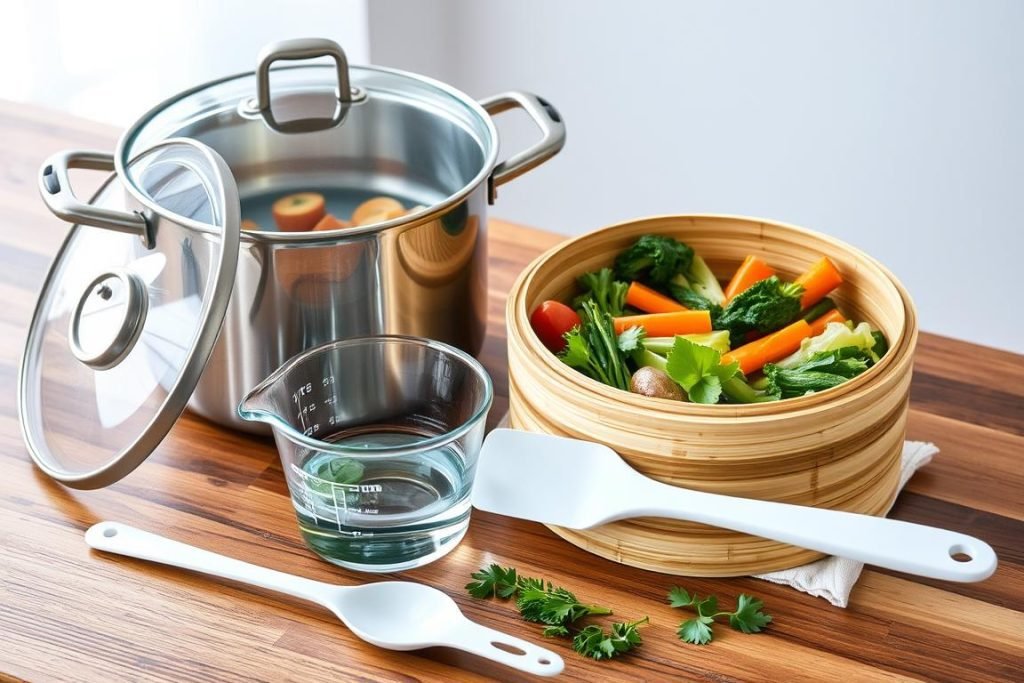
The right equipment ups your steaming game. It makes prep faster, simpler, and fun. Good tools mean a more pleasant cooking experience with fresh foods.
Preparing Ingredients for Steaming
Before steaming veggies or other items, getting ready is key for meal prep and healthy cooking. Starting right makes sure your food is delicious and good for you.
Cleaning and Cutting Your Vegetables
Pick fresh veggies like broccoli, carrots, and cauliflower. Make sure they are clean to remove dirt and chemicals. It’s important to cut them evenly for them to cook well. Cut broccoli and cauliflower into similar sizes. Carrots can be sliced or cut into sticks, whichever you like.
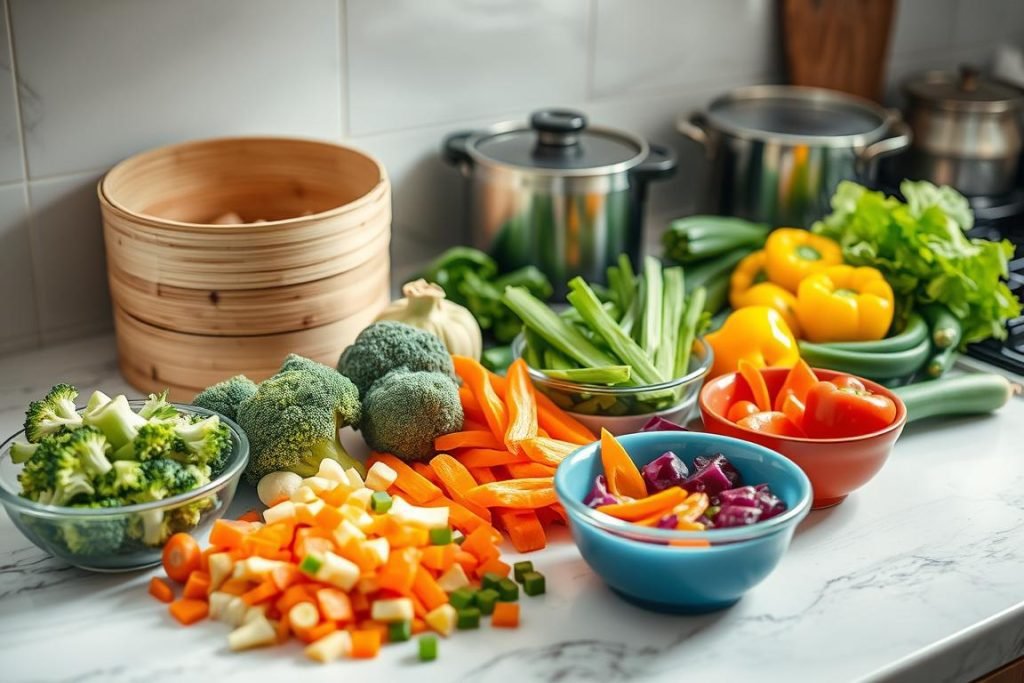
Marinating Proteins for Optimal Flavor
Marinating proteins makes them tastier. Using garlic, ginger, and low-sodium soy sauce adds extra flavor. Let fish or chicken sit in the marinade for at least 30 minutes before steaming.
Steaming vegetables keeps their taste and nutrients, which is great for healthy cooking. Below is a list of veggies good for steaming, with how to prepare them and their benefits.
| Vegetable | Preparation Method | Healthy Benefits |
|---|---|---|
| Broccoli | Chop into even florets | Preserves vitamin C and A |
| Carrots | Slice uniformly | Maintains beta-carotene |
| Green beans | Trim ends, leave whole | Keeps texture and vitamins |
| Asparagus | Remove woody ends | High in folic acid |
| Cauliflower | Cut into equal-sized pieces | Retains antioxidants |
To do well in meal prep with steaming, good prep work is important. These tips on cleaning, cutting, and marinating help you make healthy and yummy meals.
Techniques for Effective Steaming
Steaming combines healthy cooking, nutrient keeping, and quick methods. Master it to enjoy yummy meals that keep food’s natural goodness. It’s key to know how to set up, when to cook, and how to add tasty touches.
Setting Up Your Steamer
Make sure your steamer is right to keep steam in. This is important for keeping nutrients. Use either a bamboo or modern steamer but keep water from touching the food. This keeps the food’s taste and goodness.
Timing: How Long to Steam Different Foods
Different foods need different times. For example, veggies like green beans and carrots take about five minutes. They stay bright and crunchy. Fish fillets need 5 to 10 minutes. But, chicken breasts might take 10 to 15 minutes. This method is quick and keeps vitamins better than baking or frying.
Using Flavor Enhancers During Steaming
Add flavors to make steamed dishes better. Use herbs, spices, or flavored water. For instance, add a bay leaf, ginger slices, or white wine to the water. This adds taste without hiding the food’s natural flavor. It’s a healthy way to cook tasty meals.
Steaming is an old and simple cooking method. It’s loved for its benefits and simplicity. By setting up right, timing food well, and adding flavors, you’ll enjoy this method. Just be sure not to overcook. This keeps food tasty and full of nutrients.

Steaming Various Food Groups
Steaming is a great way to cook, perfect for lots of foods. It brings out the best flavors while keeping the food healthy. This makes it a top choice for vegetarian cuisine and low-fat cooking.
Steaming Vegetables: Best Practices
Cut veggies like broccoli and carrots into even sizes. This helps them cook evenly. It’s key to steam them for just 3 to 5 minutes. This way, they stay nice and crisp.
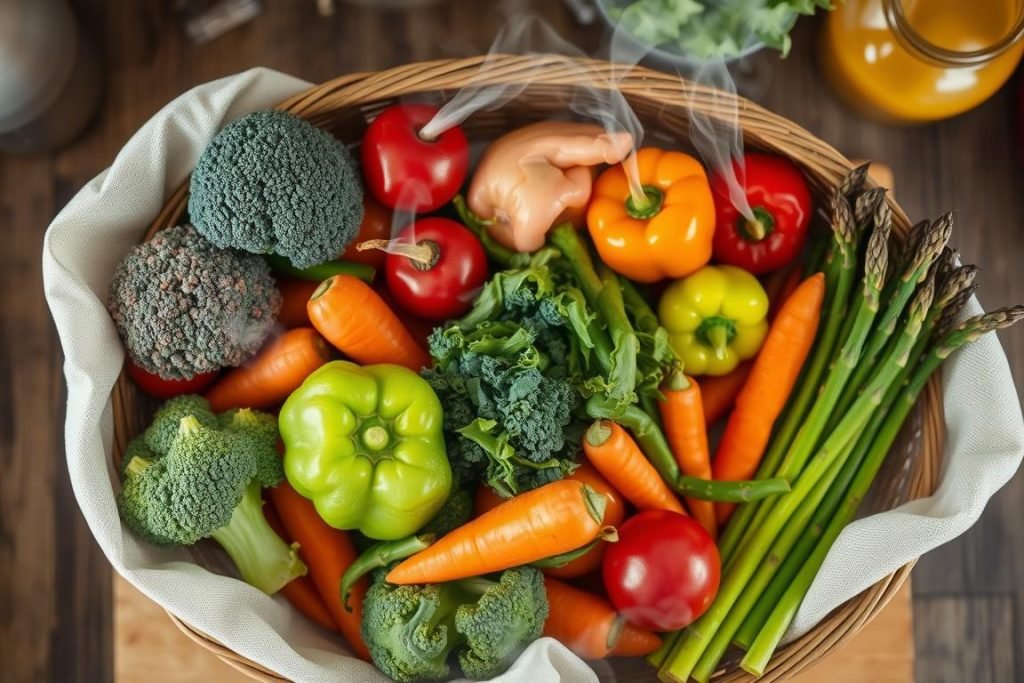
Steaming Fish and Seafood
Salmon and cod, and even mussels, are great when steamed. The steaming keeps them moist and tender. This method works well with the light taste of seafood.
Steaming Meat and Poultry
Meats and poultry need to be cooked safely. But, it’s also important not to overcook them. Steaming cooks them just right without needing lots of oil.
| Food Type | Typical Steaming Time | Nutrient Preservation |
|---|---|---|
| Vegetables (Broccoli, Carrots) | 3-5 minutes | Up to 50% more than boiling |
| Fish (Salmon, Tilapia) | 5-10 minutes | High level of Omega-3 fatty acids |
| Meat (Chicken breasts) | 20-30 minutes | Preserves proteins and vitamins |
Steaming can really up your cooking game and make your meals healthier. It’s great for those who love vegetarian cuisine or want more low-fat cooking options. Plus, it brings lots of health perks.
Troubleshooting Common Steaming Issues
Whether you’re new or skilled in cooking, steaming is key in healthy cooking. But, sometimes you might run into problems. These can affect nutrient retention and mess up your meal prep. Here’s a guide to fix these issues easily.
Overcooked vs. Undercooked Food
Finding the right cooking time is important. It helps avoid meals that are too hard or too soft. Heat doesn’t always spread the same way in steam ovens. About 35% of users say cooking is uneven. Turn your dishes halfway through to fix this.
How to Avoid Soggy Results
No one likes soggy food. It’s a big problem in steaming. To fix this, don’t fill the steamer too much. This lets steam go around better. Leaving space between food helps your dishes come out right.
Handling Steam Burns Safely
Steam burns can be very bad. Always open the steamer away from you. Use the right tools to take out hot food. Many people get hurt by steam ovens, so be careful.
It’s annoying when steam ovens don’t work right. Here’s a table with common problems and what they mean for you:
| Issue | Percentage | User Impact |
|---|---|---|
| Uneven Cooking/Heating | 35% | Requires manual adjustment |
| Scaling on Heating Elements | 25% | Decreases efficiency |
| Control Panel Display Failures | 15% | Potential for incorrect settings |
| Steam Generation Issues | 20% | Directly impacts cooking process |
| Power On Failures | 5% | Completely halts usage |
Knowing these problems helps you steam cook better. It keeps cooking healthy and enjoyable for you.
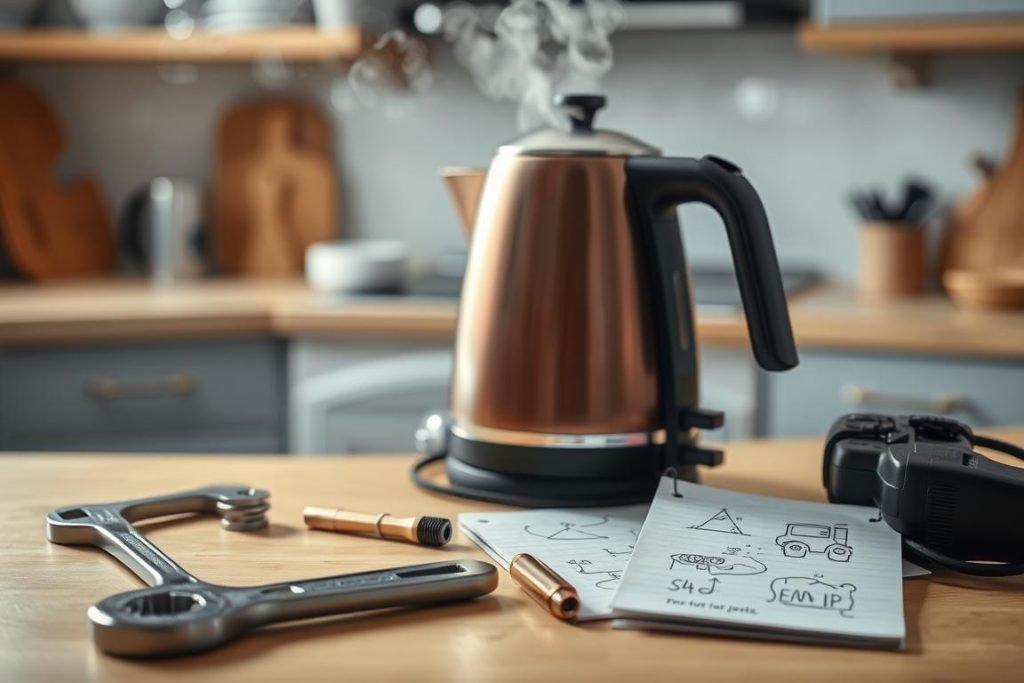
Expanding Your Steaming Techniques
Steaming isn’t just for keeping food’s good parts. It’s also about being smart and quick in the kitchen. Let’s learn some cool ways to make cooking faster. These ways will also add fun new veggie dishes to your meals.
Multi-Tier Steaming for Batch Cooking
Time-saving techniques get a big boost from multi-tier steaming. With tools like the Tatung Electric Steamer, you can cook different dishes at once. Everything stays separate, so tastes don’t mix. This is great for veggie foods that have their own special tastes.
Here, check out a table. It shows how multi-tier steaming compares with other cooking ways.
| Cooking Method | Time Efficiency | Suitability for Vegetarian Cuisine |
|---|---|---|
| Multi-Tier Steaming | High | Excellent |
| Sautéing | Medium | Good |
| Grilling | Low | Varies |
Using Steam to Reheat Food
Reheating with steam is better than microwaving or using the oven. It keeps your food moist and tasting great. Steaming for 5-10 minutes will make yesterday’s food good again. And it avoids the mushiness you get from microwaves.
Creative Recipes for Steamed Dishes
Steaming is not just for veggies and fish. Imagine making yummy steamed dumplings or cakes. You can really get creative, especially with veggie dishes. Try adding new spices or herbs for extra tasty meals.
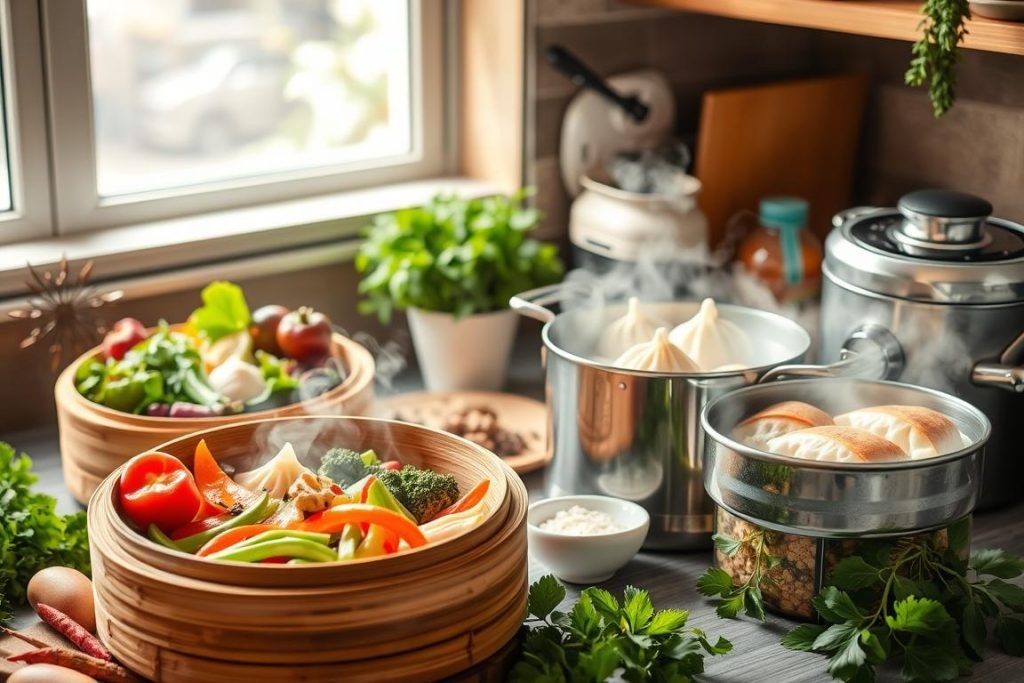
In short, getting better at steaming makes cooking easier and more fun. You can cook faster with a multi-tier steamer. Or try new tastes in veggie meals. Steaming is a winning way to cook.
Steaming in Different Cuisines
Steaming is a cooking method used worldwide. It uses steam to make food while keeping its nutrients and flavors. It’s great for low-fat cooking and keeps dietary fiber. This makes it key for tasty vegetarian cuisine and showcasing fresh produce from each area. Let’s see how steaming is used in different food traditions.
Asian Cuisine: Dim Sum and Beyond
Steaming is core to Asian food, especially in Chinese meals. It varies from simple home cooking to fancy dishes in restaurants. Dim sum includes dishes like steamed buns and dumplings. These dishes are delicious and use bamboo steamers. This method cooks food well without much oil.
Mediterranean Steamed Dishes
Steaming is also big in the Mediterranean. It makes tasty dishes from both the sea and the land. Countries like Italy and Greece steam artichokes and fish. This keeps the food’s look and nutrients. It’s why the Mediterranean diet is so healthy.
Incorporating Steaming into American Cooking
Steaming can change American cooking for the better. It makes classic dishes healthier by cutting calories and keeping vitamins. It’s a great way to cook tasty, healthy meals daily.

Learning about steaming in different foods improves our cooking and eating. Here’s a look at how steaming is used differently:
| Cooking Method | Vitamin Retention | Calorie Content | Cultural Relevance | Typical Ingredients |
|---|---|---|---|---|
| Traditional Steaming (Asian) | High | Low | Centric to daily meals and feast | Seafood, pork, vegetables |
| Steam Roasting (American) | Medium | Medium | Emerging in modern kitchens | Chicken, root vegetables |
| Light Steaming (Mediterranean) | High | Low | Common in costal gourmet dishes | Fish, leafy greens |
Each steaming method has its own unique flavors and benefits. It’s a technique worth trying in your cooking. Steaming can fit into all kinds of diets and tastes, whether for health or trying new foods.
Conclusion: Elevate Your Cooking with Steaming
Steaming changes how you make meals. It makes cooking healthy and keeps nutrients in your food. Colors stay bright and food tastes great without extra fats or oils.
Recap of Key Points
We talked about using the right tools like steamer baskets and the Ciarra Nosh Oven. These help cook food well and keep it moist. Getting ingredients ready helps them soak up flavors and cook just right.
Steaming makes your veggies and seafood perfectly tender but crisp. It keeps about 90% of the nutrients. This is way better than boiling, which can remove important vitamins.
Encouragement to Experiment with Steaming
Steaming lets you be creative in the kitchen. You can steam a whole fish or make leftovers good as new. This way of cooking is healthy and lets you have fun with different flavors.
Steaming veggies adds only 25 calories per half-cup but keeps taste and moisture. It’s a great choice for eating well without losing out on flavor.
Resources for Further Learning on Steaming
Learning more about steaming can really up your cooking game. Look for new cooking ideas, techniques, and recipes. Be bold in your kitchen choices. Let steaming not just cook but improve your food and health.
A steamer is key to unlocking what ingredients can do. It urges you to find cooking fun again and to enjoy healthy meals.